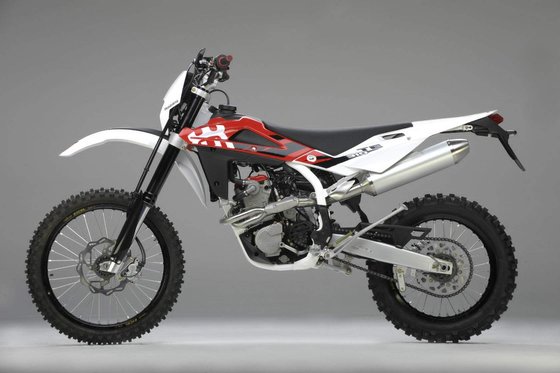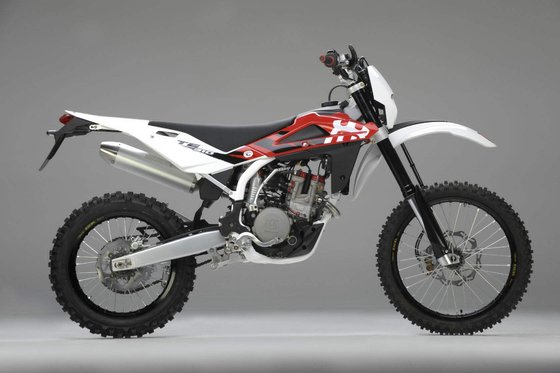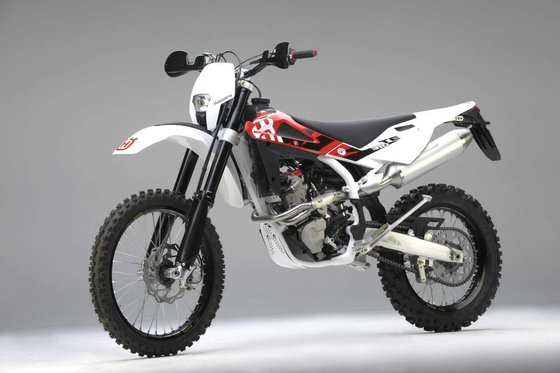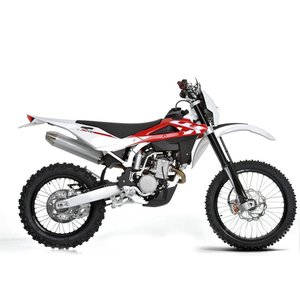Husqvarna TE 310 (2009-2010): The Perfect Middleweight Enduro?

Introduction
The Husqvarna TE 310 occupies a unique space in the enduro world – a bridge between the agility of 250cc machines and the brute force of 450cc thumpers. Produced from 2009 to 2010, this Italian-designed warrior (pre-KTM acquisition era) was engineered for riders who demanded precision in technical terrain without sacrificing mid-range punch. Let’s dissect why this short-lived model remains a cult favorite among hardcore enduro enthusiasts.
Design & Ergonomics: Form Follows Function

Husqvarna’s design philosophy for the TE 310 screamed “race-ready” even at standstill. The 2009 refresh brought black-anodized Excel rims, aggressive angular bodywork, and a minimalist LED-compatible headlight cluster that looked like it belonged on a Tron sequel. At 107 kg (235.9 lbs) dry weight, it felt shockingly light when shouldering through mud pits or pivoting on tight singletrack.
The steel single-tube cradle frame shed 1 kg compared to previous generations, enhancing rigidity while maintaining that signature Husky flex for predictable traction. Standover height at 963 mm (37.9") intimidated shorter riders, but the narrow mid-section allowed confident dab-free footwork. Grips and footpegs arrived unapologetically slim – a clear nod to competition priorities over all-day comfort.
Engine: The Sweet Spot Between 250 and 450
Technical Heartbeat
- 297.8cc DOHC 4V Single: Bore increased to 83mm (from TE250’s 76mm)
- Mikuni D42 Fuel Injection: Rare for era – no carburetors to fuss with
- 12.9:1 Compression: Required premium fuel but delivered crisp throttle response
- 6-Speed Transmission: Wide-ratio gearing for crawling or highway dashes

Riding Impressions
Fire up the TE 310 via electric starter (or kick if you’re nostalgic), and its character emerges immediately. Unlike peaky 250s, torque builds linearly from 3,000 RPM, pulling cleanly through to 9,500 RPM without dramatic hits. The Mikuni injection system – advanced for late-2000s enduros – eliminated bogging during sudden throttle chops in rock gardens.
On hill climbs, the 310cc mill offered just enough grunt to tractor up without terrifying wheelies. Sixth gear cruised comfortably at 100 km/h (62 mph), though windblast reminded you this wasn’t a dual-sport. Savvy riders appreciated the steel exhaust valves and revised oil filter – durability upgrades from earlier Husqvarna models.
Chassis, Suspension & Brakes: Precision Toolbox
Front End Dominance
- 50mm Marzocchi USD Forks: 300mm (11.8") travel handled G-outs like a pogo champion
- Adjustability: 22-click compression/rebound – softer stock setup for trail forgiveness
- Triple Clamp Geometry: 26.5° rake kept steering lively without headshake
Rear Symphony
- Sachs Soft Damp Shock: Progressive linkage ate up square-edged hits
- 296mm Wheel Travel: Matched front/rear balance during whoops
- Preload/Clicks Galore: Tuned heavier riders could dial in sag easily
Braking Credentials
- 260mm Front / 240mm Rear Brembo Wave Discs: Bite > fade resistance
- Modulation Mastery: One-finger stoppies achievable after practice
Wheel/Tyre Package
- 21” Front / 18” Rear: Gold-standard enduro sizes
- 120/80-18 Rear Tyre: Enough footprint for loamy climbs without drag
On the Trail: Where the TE 310 Shines
Throw a leg over the TE 310, and within minutes, its intentions are clear: technical terrain domination. The combination of slim profile and 1495mm (58.9”) wheelbase inspired confidence in switchbacks that’d leave 450cc riders wrestling handlebars.
First Gear Crawling: Idle up rock slabs with clutch barely feathered – torque delivery smooth as Swedish butter.
Third Gear Flow: Charge through wooded trails; suspension swallowed root networks while the engine purred.
Fifth Gear Escapes: Escape angry wasp nests at 80 km/h (50 mph) with minimal vibration through alloy pegs.
Fuel range proved its Achilles’ heel – 7.2L (1.9 gal) meant 90-110 km (56-68 mi) between fill-ups. Carry a MSR bottle unless racing.
Competition: How It Stacked Up
1. Yamaha WR250F
- Pros: Legendary reliability, plush suspension
- Cons: Carbureted, 15% less power, 8kg heavier
- TE 310 Edge: Fuel injection, flickable chassis
2. KTM 350 EXC-F
- Pros: More modern tech (2010+), street legal
- Cons: 12kg heavier, higher seat height
- TE 310 Edge: Raw, race-bred aggression
3. Honda CRF250X
- Pros: Beginner-friendly, low maintenance
- Cons: Underpowered for expert riders
- TE 310 Edge: DOHC engine revved harder
Maintenance: Keeping the Beast Alive
As MOTOPARTS.store journalists, we prioritize longevity. Key considerations:
Critical Service Intervals
- Oil Changes: Every 15 hours (1L Motorex 10W-50)
- Air Filter: Clean after 10 dusty hours (No Toil recommended)
- Valve Checks: 30 hours – shim-under-bucket needs patience
Upgrade Recommendations
- Skid Plate: Stock plastic side guards insufficient for boulder strikes
- Handguards: Protect levers from tree love taps
- Sprocket Swap: 13T front + 52T rear for tighter trails
Common Issues
- Stator Failures: Upgrade to Ricky Stator unit
- Fuel Pump Relays: Keep spares in toolkit
- Swingarm Pivot: Grease monthly to prevent seizure
Conclusion: A Forgotten Gem?
The Husqvarna TE 310 wasn’t perfect – its limited production run and niche positioning saw it overshadowed by Austrian rivals. Yet for technical riders valuing precision over peak horsepower, it remains a weapon. Modern upgrades like LED lighting kits and lithium batteries only sweeten the deal.
At MOTOPARTS.store, we keep these legends roaring with OEM-spec parts and performance mods. Whether you’re rebuilding a 2010 TE 310 or upgrading your current steed, our catalog delivers the goods without the dealership markup.
Now, go get dirty.



















